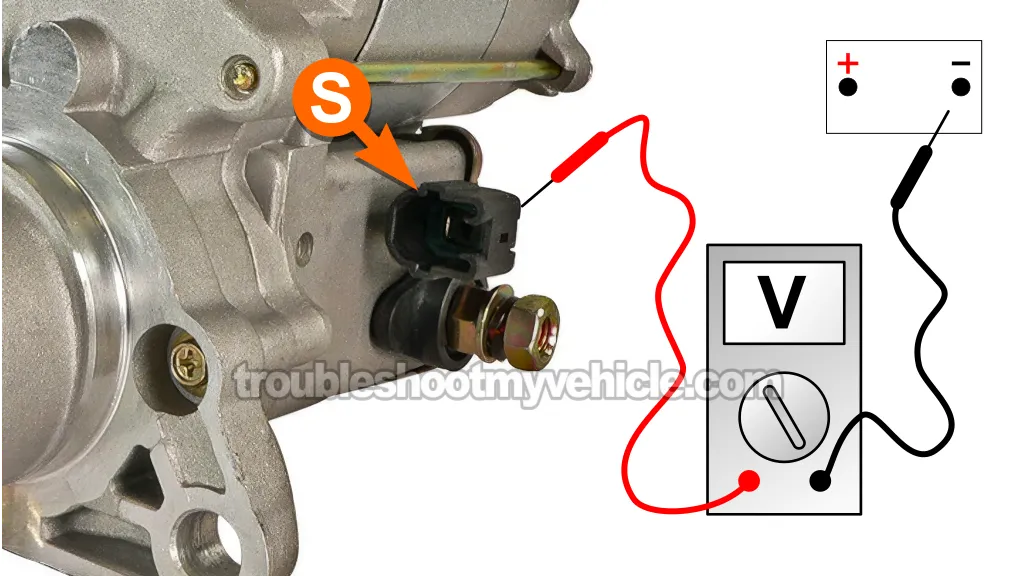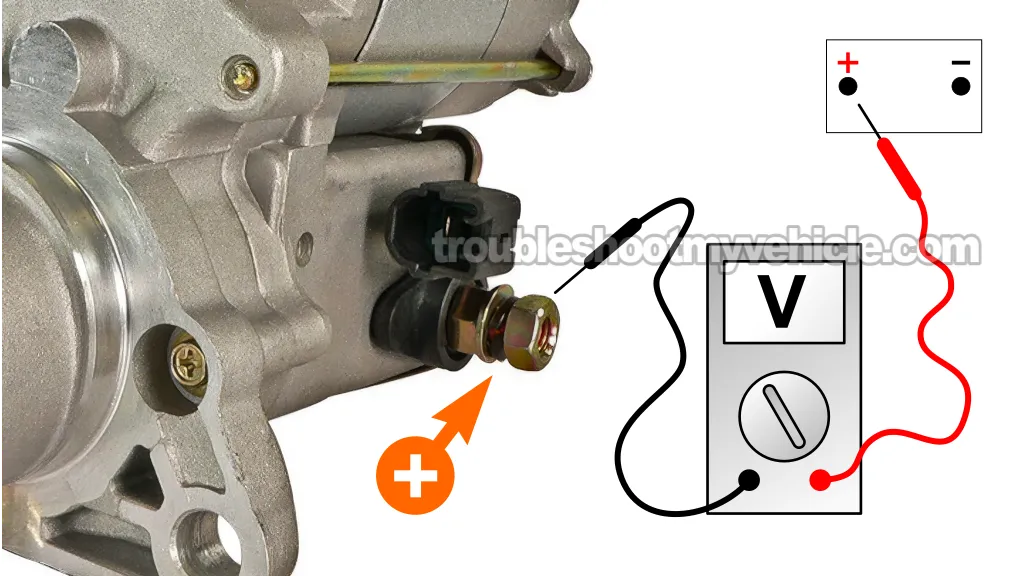TEST 2: Verifying The 12 Volt Start Signal

When you turn the key to start the engine, the starter motor gets an activation (START) signal.
This START signal comes through the wire connected to the starter motor solenoid's 'S' terminal.
In this section, we're gonna do a simple multimeter voltage test to see if that signal is present when the ignition key is turned to the START position.
Let's get to it:
- 1
Place your multimeter in Volts DC mode.
- 2
Ground the black multimeter test lead directly on the negative (-) battery terminal using a jump start cable.
You can also Ground it on the engine, if you can find a clean, unpainted and rust-free spot of metal. - 3
Connect the red multimeter test lead to the female terminal of the 'S' wire using an appropriate tool.
NOTE: The multimeter test lead must be connected to the female terminal of the 'S' wire and NOT the male spade 'S' terminal on the starter motor. - 4
Have your helper turn the key to crank the engine when the test is setup.
NOTE: Even tho the engine isn't gonna crank, we still need to turn the key to the START position for this test to work. - 5
Your multimeter should read 10 to 12 Volts DC.
OK, let's break down your test results:
CASE 1: Your multimeter showed 10 to 12 Volts. That's the right result, meaning the starter motor's getting its activation signal.
If the starter motor failed TEST 1: This usually means it's bad. But before swapping it out, we're gonna do one more check: TEST 3: Voltage Drop Testing The Battery (+) Cable.
If the starter motor passed TEST 1: This points to an intermittent problem. If the starter motor cranks the engine when doing TEST 1 and the START signal is present in the 'S' terminal wire, then all systems are working at the moment.
CASE 2: Your multimeter DID NOT show 10 to 12 Volts. That means the starter motor isn't getting an activation signal. Without the START signal, the engine is not gonna crank.
Tracking down why that signal's missing is beyond the scope of this tutorial, but here are the most common culprits:
- A bad starter motor relay.
- A faulty park-neutral safety switch (automatic transaxle).
- A bad clutch pedal switch (manual transaxle).
- A bad ignition switch.
TEST 3: Voltage Drop Testing The Battery (+) Cable

The starter motor connects straight to the battery's positive (+) post with a battery cable. Sometimes, this cable builds up corrosion.
If too much corrosion forms, the starter motor won't get the battery's full amperage. When that happens, the engine won't crank.
In this final test, we'll check if the battery cable is letting the full amperage reach the starter motor by running a simple multimeter voltage drop test.
IMPORTANT: The image above shows the battery (+) cable disconnected from the '+' terminal stud just to make it easier to explain the connections. Don't disconnect the battery cable from the '+' stud, it has to remain in place to accomplish this test.
Here's how to do it:
- 1
Place your multimeter in Volts DC mode.
- 2
Attach the red multimeter test lead to the positive (+) battery post. The positive (+) battery post must be clean and corrosion-free.
You may need two helpers for this test step, since someone will have to hold the red multimeter test lead onto the battery positive (+) post and someone else inside the vehicle (to crank it when everything is set up). - 3
Place the black multimeter test lead on the starter motor solenoid stud that connects to the battery positive (+) cable (see illustration above).
The orange arrow with the plus (+) sign, in the illustration above, points to this stud.
Maintain the black multimeter test lead in this position throughout the next step. - 4
When everything is ready, have your helper turn the key to crank the engine.
Although the starter motor won't crank the engine, your helper has to turn the ignition switch to start the engine for the voltage drop test to work. - 5
The multimeter should register 0.5 Volts or less (0.5 V = 0 Volts).
If there's a problem in the wire, your multimeter will register some voltage, usually 5 Volts or more.
Let's break down what your results mean:
CASE 1: Your multimeter showed NO voltage drop (0.5 Volts or less). That's the right result, proving the starter motor is getting all the battery voltage and amperage it needs to crank the engine.
If you've confirmed all of the following, then the starter motor is bad and needs to be replaced:
- The starter motor didn't crank the engine (TEST 1).
- The starter motor is getting an activation signal (TEST 2).
- This test shows the battery's positive (+) cable doesn't have a voltage drop issue.
Before removing the starter motor, there's one more thing you should do:
- Manually turn the engine using a 1/2 ratchet and the right socket on the crankshaft pulley bolt. This checks if the engine is mechanically locked up.
Want to bench test the starter motor after removing it? Follow the step-by-step guide here:
- How To Bench Test A Starter Motor (Step By Step) (at: easyautodiagnostics.com).
CASE 2: Your multimeter showed 5 Volts or more. That means the starter's battery wire has corrosion or a bad connection —definitely not good since it'll stop the battery's full amperage from reaching the starter motor.
To fix it, you've gotta clean both ends of the battery's positive (+) cable really well.
Use a small piece of sandpaper to clean the end that connects to the starter motor solenoid. Once both ends are clean, reconnect everything, making sure all connections are torqued correctly and try cranking the engine.
If the voltage drop (or a loose connection) was the issue, the starter motor should fire up and crank the engine now.
More 2.2L Toyota Camry Tutorials
You can find a complete list of 2.2L Toyota Camry tutorials and wiring diagrams in this index:
Here's a sample of the tutorials you'll find there:
- How To Test Engine Compression (1990-2001 2.2L Toyota Camry, Celica).
- How To Test For A Blown Head Gasket (1990-2001 2.2L Toyota Camry, Celica).
- How To Test The Fuel Pump (1996-2001 2.2L Toyota Camry).
- How To Test The TPS With A Multimeter (1997-2001 2.2L Toyota Camry).

If this info saved the day, buy me a beer!

